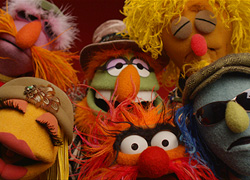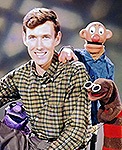Okay, I know that the aspect ratio 1.33:1 is full-screen, and that 1.85:1 (or something like that) is wide-screen, so what's 2.35:1? Is that where the black bars are so large that they take up the top third and bottom third of the entire frame, and leave the middle third with a partial picture?
-
 Welcome to the Muppet Central Forum!
Welcome to the Muppet Central Forum!
You are viewing our forum as a guest. Join our free community to post topics and start private conversations. Please contact us if you need help. -
 Back to the Rock Season 2
Back to the Rock Season 2
Fraggle Rock Back to the Rock Season 2 has premiered on AppleTV+. Watch the anticipated new season and let us know your thoughts. -
 Sesame Street Season 54
Sesame Street Season 54
Sesame Street Season 54 has premiered on Max with new episodes each Thursday. Watch and let us know your thoughts. -
 The Muppets Mayhem premieres
The Muppets Mayhem premieres
The series debut of the year is here! Let us know your thoughts and reviews of The Muppets Mayhem now streaming on Disney+. -
 Bear arrives on Disney+
Bear arrives on Disney+
The beloved series has been off the air for the past 15 years. Now all four seasons are finally available for a whole new generation. -
 Sam and Friends Book
Sam and Friends Book
Read our review of the long-awaited book, "Sam and Friends - The Story of Jim Henson's First Television Show" by Muppet Historian Craig Shemin.
2.35:1?
- Thread starter D'Snowth
- Start date
Winslow Leach
Well-Known Member
- Joined
- Feb 22, 2007
- Messages
- 3,620
- Reaction score
- 13
The actual aspect ratio today (well, since 1970) is 2.40 (or, if you want to be more specific, 2.39:1). This is 35 mm anamorphic, and approximates the full theatrical image, so you're gaining more picture, despite the smaller size, compared to say, a picture shot in 1.85:1.Okay, I know that the aspect ratio 1.33:1 is full-screen, and that 1.85:1 (or something like that) is wide-screen, so what's 2.35:1? Is that where the black bars are so large that they take up the top third and bottom third of the entire frame, and leave the middle third with a partial picture?
2.35:1 was called CinemaScope in the 1950s (when it debuted) and 1960s. This was an early version of Panavision, and first used, I believe, in the 1953 biblical epic, The Robe.
2.35:1 is still commonly referred to today for anamorphic films (especially on the back of video boxes), but the truth is, the actual OAR is 2.39:1. The change is very subtle. But I've been noticing that DVDs have been rounding it off to 2.40 on the back of their cases more and more these days.
furryredmonster
Well-Known Member
- Joined
- Oct 3, 2006
- Messages
- 442
- Reaction score
- 2
o_o
MrsPepper
Well-Known Member
- Joined
- Dec 23, 2004
- Messages
- 4,333
- Reaction score
- 75
Nice description, Winslow!The actual aspect ratio today (well, since 1970) is 2.40 (or, if you want to be more specific, 2.39:1). This is 35 mm anamorphic, and approximates the full theatrical image, so you're gaining more picture, despite the smaller size, compared to say, a picture shot in 1.85:1.
2.35:1 was called CinemaScope in the 1950s (when it debuted) and 1960s. This was an early version of Panavision, and first used, I believe, in the 1953 biblical epic, The Robe.
2.35:1 is still commonly referred to today for anamorphic films (especially on the back of video boxes), but the truth is, the actual OAR is 2.39:1. The change is very subtle. But I've been noticing that DVDs have been rounding it off to 2.40 on the back of their cases more and more these days.
D'Snowth, I'm not sure if you are aware or not, but those bars don't actually exist. They just appear there because the picture is wider than your tv is.Is that where the black bars are so large that they take up the top third and bottom third of the entire frame, and leave the middle third with a partial picture?
As both yourself and Winslow just described, movies are filmed on very wide film, which is a different aspect ratio than a tv, which is nearly square.
Full-frame movies fit the top and bottom of your film to the size of your tv and lose the excess on the sides. Widescreen movies make sure that everything on the sides fits, and blank space appears at the top and bottom to make up for the fact that a TV is square and movies are not. So even though with widescreen it looks smaller, you actually see more of the image than a fullscreen dvd.
Winslow Leach
Well-Known Member
- Joined
- Feb 22, 2007
- Messages
- 3,620
- Reaction score
- 13
Here's a quick rundown of the most common aspect ratios:
1.33:1 - this was the OAR of silent films and early talkies, used until 1932. It is also the standard for most television programs, past and present, as 4:3.
1.37:1 - known as "Academy Ratio," it debuted in 1932, and was the standard for most motion pictures until 1953. If you're watching a film in this format on TV, nothing is cropped or lost.
1.66:1 - European widescreen standard.
1.78:1 - video widescreen standard.
1.85:1 - the standard format for most U.S. and U.K. theatrical films.
2.2:1 - a now-rare format, known as Todd-AO, because it was co-developed by Broadway producer Mike Todd, with the American Optical Company. Todd-AO is extremely high definition widescreen, and used only on a handful of films, mostly produced as "event" or "road show" entertainments, in which you often had to buy a ticket in advance, as if you were attending a Broadway show, and were given assigned seating. This was the first film format to utilize 70mm prints, followed by Panavision's Super Panavision 70 and Ultra Panavision 70, which are standards today. But Mike Todd pioneered the format.
Major films produced in 70mm Todd-AO include:
Oklahoma! (1955)
Around the World in 80 Days (1956)
South Pacific (1958)
The Alamo (1960)
Cleopatra (1963)
The Sound of Music (1965)
The Agony and the Ecstasy (1965)
The Bible (1966)
Dr. Dolittle (1967)
Hello, Dolly! (1969)
Patton (1970)
Todd-AO faded out in the early 1970s, but re-appeared in the early 1990s, and was most famously used that decade in Kenneth Branagh's Hamlet (1996), the last major production to date to use the original Todd-AO.
2.35:1 - or CinemaScope. Used extensively from 1953 to 1970. 35mm anamorphic.
2.39:1 - the current widescreen format, in use since 1970. Often rounded off to 2.40. As Mrs. Pepper said, the black bars on the top and bottom of the screen don't actually exist. The picture is wider than, say a 27-inch TV screen. Despite the smaller size, you're getting approximately everything the director wanted you to get, without having to crop or pan-and-scan the image.
1.33:1 - this was the OAR of silent films and early talkies, used until 1932. It is also the standard for most television programs, past and present, as 4:3.
1.37:1 - known as "Academy Ratio," it debuted in 1932, and was the standard for most motion pictures until 1953. If you're watching a film in this format on TV, nothing is cropped or lost.
1.66:1 - European widescreen standard.
1.78:1 - video widescreen standard.
1.85:1 - the standard format for most U.S. and U.K. theatrical films.
2.2:1 - a now-rare format, known as Todd-AO, because it was co-developed by Broadway producer Mike Todd, with the American Optical Company. Todd-AO is extremely high definition widescreen, and used only on a handful of films, mostly produced as "event" or "road show" entertainments, in which you often had to buy a ticket in advance, as if you were attending a Broadway show, and were given assigned seating. This was the first film format to utilize 70mm prints, followed by Panavision's Super Panavision 70 and Ultra Panavision 70, which are standards today. But Mike Todd pioneered the format.
Major films produced in 70mm Todd-AO include:
Oklahoma! (1955)
Around the World in 80 Days (1956)
South Pacific (1958)
The Alamo (1960)
Cleopatra (1963)
The Sound of Music (1965)
The Agony and the Ecstasy (1965)
The Bible (1966)
Dr. Dolittle (1967)
Hello, Dolly! (1969)
Patton (1970)
Todd-AO faded out in the early 1970s, but re-appeared in the early 1990s, and was most famously used that decade in Kenneth Branagh's Hamlet (1996), the last major production to date to use the original Todd-AO.
2.35:1 - or CinemaScope. Used extensively from 1953 to 1970. 35mm anamorphic.
2.39:1 - the current widescreen format, in use since 1970. Often rounded off to 2.40. As Mrs. Pepper said, the black bars on the top and bottom of the screen don't actually exist. The picture is wider than, say a 27-inch TV screen. Despite the smaller size, you're getting approximately everything the director wanted you to get, without having to crop or pan-and-scan the image.
Winslow Leach
Well-Known Member
- Joined
- Feb 22, 2007
- Messages
- 3,620
- Reaction score
- 13
Thanks, Mrs. P!Nice description, Winslow!

Winslow Leach
Well-Known Member
- Joined
- Feb 22, 2007
- Messages
- 3,620
- Reaction score
- 13
Are you thinking of Glen Glenn sound? Todd-AO and Glen Glenn (a sound system company that was an industry standard for years) did team up.I thought Todd-AO was a company that supplied laugh tracks for shows back in the 60s and 70s?
A quick bio on the colorful Mike Todd...
He produced over 30 Broadway shows. Some of them were failures, and he wound up bankrupt more than once.
He co-founded The Cinerama Company, which was a film process that used three film projectors to create a giant composite image on a curved screen. He left Cinerama to co-found Todd-AO.
He produced the lavish film spectacle (in Todd-AO, of course) Around the World in 80 Days (1956), featuring an all-star cast. Earlier, he had attempted an ambitious stage version of the Jules Verne novel, but it was a flop. The film went on to win the Academy Award for Best Picture.
Todd married Elizabeth Taylor in 1957.
In 1958, his private plane, "The Lucky Liz" crashed, killing Todd and three other passengers. Liz Taylor was supposed to accompany Todd on his fatal flight, but backed out at the last minute. She claimed Todd was the love of her life.
Mistersuperstar
Well-Known Member
- Joined
- Sep 14, 2006
- Messages
- 797
- Reaction score
- 4
This guy really knows his stuff! I remember seeing a program years back about "Cinerama" movies like How The West Was Won. They used more than one camera to create a panoramic-like picture.
erniebert1234ss
Well-Known Member
- Joined
- Jul 31, 2002
- Messages
- 1,010
- Reaction score
- 8
Huh. No wonder I can barely watch the R&H VHS tapes of Oklahoma! and The Sound of Music! I never knew they were in that super-hi-def widescreen format!Major films produced in 70mm Todd-AO include:
Oklahoma! (1955)
Around the World in 80 Days (1956)
South Pacific (1958)
The Alamo (1960)
Cleopatra (1963)
The Sound of Music (1965)
The Agony and the Ecstasy (1965)
The Bible (1966)
Dr. Dolittle (1967)
Hello, Dolly! (1969)
Patton (1970)
Todd-AO faded out in the early 1970s, but re-appeared in the early 1990s, and was most famously used that decade in Kenneth Branagh's Hamlet (1996), the last major production to date to use the original Todd-AO.
If you got the recent Complete Droopy DVD set, you noticed the new 16x9 Transfers of the CinemaScope Droopy shorts (which are okay).2.35:1 - or CinemaScope. Used extensively from 1953 to 1970. 35mm anamorphic.
BJ
